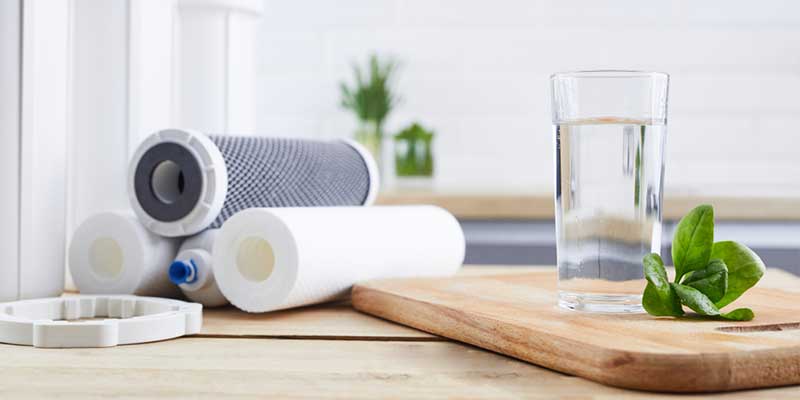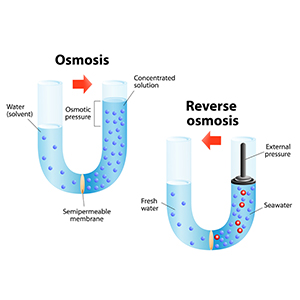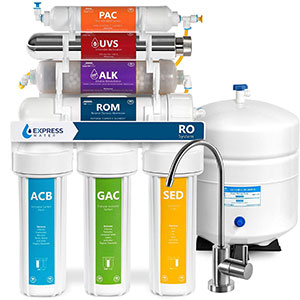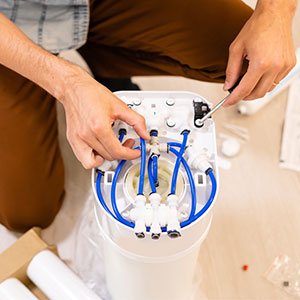How Long Does a Whole House Reverse Osmosis System Last?

The advancement of science and urbanization has surely made our lives much easier but it also affected our natural resources. Especially, it contaminated our water to a great extent.
Although it’s quite hard to find safe drinking water, thanks to the reverse osmosis system which can provide the safest water to use in our everyday life. If you are thinking of installing an RO system for your whole house then you can not go wrong with this decision. But you might wonder how long an RO system lasts or other related matters to it.
Now, the core question is, how long does a whole house reverse osmosis system last?
A whole house reverse osmosis can last up to 15 to 20 years if you maintain it in proper ways. You will need to change those filters from time to time and clean the tank on a yearly basis.
There is more to learn about the RO system. Let’s dive into the article to get a deeper handle on the knowledge.
What is Reverse Osmosis?
Reverse Osmosis is a very effective water purification process that uses a semi-permeable membrane to separate ions and larger molecules from water that are harmful to our body to leave pure H2O behind.
In this process, water is pushed through a pressurized environment in order to deionize and demineralize the water. The fresh drinking water that comes out of this process is called “Permeate” and the leftover concentrated and contaminated water is called “Brine”.
The semipermeable membrane used in this process is a synthetic lining that helps leave behind the contaminants and sediments like salt, chlorine, and dirt from drinking water.
How Does a Reverse Osmosis System Work?
To understand reverse osmosis clearly, let’s learn about the natural osmosis process first.
 Osmosis is a natural process where a particular solvent passes through a semipermeable membrane from higher to lower concentrations. We can find this process in nature very often but the most common example of it is a tree consuming nutrients from the soil. As the name suggests, the reverse osmosis system works in the opposite process of osmosis. In this process, the water passes through a semipermeable membrane but the unpurified water has a lower concentration where purified water has a higher concentration.
Osmosis is a natural process where a particular solvent passes through a semipermeable membrane from higher to lower concentrations. We can find this process in nature very often but the most common example of it is a tree consuming nutrients from the soil. As the name suggests, the reverse osmosis system works in the opposite process of osmosis. In this process, the water passes through a semipermeable membrane but the unpurified water has a lower concentration where purified water has a higher concentration.
Basically, it goes from lower concentration to higher concentration that is completely opposite from the natural osmosis process. To conduct this reverse process, external pressure is used to purify the contaminated water.
This external pressure helps the contaminated water to go through the membrane in order to remove the contaminations and produce safe drinking water. This is how the reverse osmosis system works.
How Long Does a Whole House Reverse Osmosis System Last?
Generally, a whole house reverse osmosis system is designed to last for 15 to 20 years if it’s well taken care of. The RO system requires routine maintenance to run perfectly.
The filters and membranes of the reverse osmosis system need a change in regular intervals to provide service for such a long time. The need for a change of the filters and membrane depends on the water of a particular place.
How Often Do You Need to Replace Your RO Filters?
You will need to change your reverse osmosis water system filters on a routine basis in order to get a fresh, pure water supply.
The semipermeable membrane used in the RO system needs changing in between two to five years. But it may vary due to the quality of water and your water usage.
The RO filtration system has three, sometimes four filters to purify the water. There is a sediment pre-filter, the reverse osmosis membrane, a carbon pre filter, and a carbon post filter. All of these filters need to be changed on a routine basis to run the system perfectly. It can not be said for sure how often to change your filters. Because not everyone’s water usage amount is the same. A family of eight people will obviously use more water than a family of four. So, the bigger family will need to change their filters more often than the smaller family.
So, you may need to change your filters on a year-to-year basis. This is an approximate guess for a normal RO system. This time may vary due to water usage and water quality. But you will need to change those filters every six months or in a year top.
The RO purification system also uses UV lamps and quartz sleeves to remove contamination from the water. The UV lamps must be replaced every year, while the quartz sleeves must be replaced every other year.
How Much Does a Whole House Reverse Osmosis System Cost?
The whole house reverse osmosis system installation cost actually depends on the output of the water for the whole house. A bigger house with a bigger family will need more water supply than a smaller house with a smaller family. A whole house reverse osmosis system can cost you around 1500 dollars to 2800 dollars depending on your water demand for the entire house. The reverse osmosis purification system comes in two different types.
One of them is the Point of Use (POU) system which is installed in the faucets and works for the kitchen sink, shower, washer, and refrigerator. Another one is the Point of Entry (POE) system which is installed in the main water point from where the supply comes. This system is great for homes that have water softeners and have a supply of hard water, high chlorine water, well water or use the rainwater.
Most of the houses use the POE system because it provides you with the safest purified water. And installing this system will cost you between 500 dollars to 2800 dollars depending on the size of your house and your water supply needs.
If your house needs a large amount of water supply then you will need to install a much larger tank and that will cost you extra money. You can install the system at your house all by yourself but just to be on the safe side, get it done by a professional. Otherwise, a small mistake can cost you a lot more money in addition to the already expensive purification system.
And there is also a chance of getting contaminated water if you are not well aware of how to install the RO system. Therefore, it will be a wise decision to seek professional help for installing the RO system in your house.

Do You Need a Whole House Reverse Osmosis System?
Using a whole house reverse osmosis system makes sense if you are living in an area where there are lots of contaminants in the water like PCB, TCE, arsenic, nitrates, etc. But if you have a municipal water supply at home, then maybe you don’t actually need a whole house RO system because it will unnecessarily cost you a lot of money.
The reverse osmosis system is widely used in rural areas where the water contains a high level of concentrated salts, arsenic, nitrates, PFAs, etc. These components are very hard to remove from water and the whole house RO system is effective and most useful in this scenario. The POE system is necessary for such areas.
In the urban areas, municipal water supplies are purified by chlorination which helps to reduce contaminants found in the water. So, the RO system is not quite used in urban areas. People who use the RO system there, use the POU system which is less expensive.
So if you are living in an area near a manufacturing plant and the water is highly contaminated, then you should go for the POE reverse osmosis system. And if you are living in an area with a municipal water supply then you may not need to install a whole house reverse osmosis system and burn a hole in your wallet.
But if you are still concerned about the TDS(Total Dissolved Solids) level of the water then you can install a POU reverse osmosis system at your kitchen sink for a purified drinking water supply. It will save you hard-earned money.
How to Maintain a Reverse Osmosis System?
A reverse osmosis system needs regular maintenance to run smoothly and provide you with fresh uncontaminated water.
The tips below will help you maintain the reverse osmosis system.

Replace the Filters and Membrane Regularly
The RO system uses three or four filters to supply fresh, purified water. You need to change those filters on a routine basis for an uncontaminated water supply.
Let’s see when you should replace the filters according to their needs.
Sediment Filters
Sediment filters work by preventing dirt from passing through the system so that the dirt doesn’t reach the membrane and clog it. You should change the sediment filters every year.
Carbon Filters
These carbon block filters need to be replaced according to the water quality of your area. Usually, it needs to be changed between six months to one year. You might need to change it more often if the water in your area is highly contaminated.
Reverse Osmosis Membrane
This is a semipermeable membrane which is a synthetic lining that helps the water move from a lower concentration to a higher concentration. This membrane needs changing every 2-3 years depending on how well you can maintain your RO system.
Polishing Filters
This is the final carbon filter, also called post carbon filter, which helps remove any odor and taste from the water. It needs changing every 6-12 months depending on how much odor the water contains in your area.
Clean and Sanitize the Tank
Your RO tank needs routine cleaning and sanitizing just as much as the filters need to be changed. Otherwise, how much you purify the water with the filters, you will get a contaminated water supply due to the dirty tank.
Let’s see if you can clean your RO tank annually.
How to Clean and Sanitize the RO Tank
- First, turn off the main valve of the RO tank.
- Now, drain all the water using the RO faucet.
- Next, remove the sediment and carbon filters from their housing.
- After that, remove the RO membrane.
- Now, screw the housings back into their places but don’t install the new filters yet.
- At this point, pour a cup of hydrogen peroxide into the first stage housing.
- Now attach all the connections.
- And now turn the main valve on.
- Let the system run without filters. The water will keep filling in the tank rapidly.
- Allow the system to complete at least 2 whole cycles.
- Now turn off the main valve again.
- Then, install the intact filters.
- Lastly, let the tank fill up one more time and let the water dispense one more time.
After completing all of these processes, your RO system will be clean and ready to run again. Just remember to keep the place around the tank clean and wear gloves when you clean the RO tank.
Clean and Reassemble Plumbing Pipes
Your kitchen pipes need cleaning in order to clean the water supply and keep them clog-free. You should clean those pipes if you have an RO system in your house or not. You can simply clean them by draining a solution of salt and hot water through the pipes. You don’t need to call a plumber to perform this simple cleaning method. Just make sure to clean those pipes several times a year.
A Whole House Reverse Osmosis System- Pros and Cons
Even though you think a reverse osmosis system only provides you advantages, this system has some downsides too.
Let’s see some of them in the following discussion.
- RO system has a multi-stage water filtering method that ensures you the purest water.
- The semipermeable membrane reduces dissolved solids and chemicals in your water.
- The chemical filtering in the carbon filters removes chlorine and fluoride from the municipal water.
- The RO system uses the water pressure from your home water so you don’t need to install an extra power outlet to keep the system running.
- You might think installing an RO system is too expensive but in the long run, it saves your money. You can actually buy an RO system for less than the cost of 10 gallons of water.
- The reverse osmosis system removes impurities from your water that causes odors.
- The RO system provides you with the purest water. And you will get clearer ice with this pure water.
- The sediments and debris in your water can clog the filters and you may need to change those more often and can cost you extra money.
- Installation costs can be too high for some people.
- As the RO system has a multi-stage water purification method, it takes time to fill the tank properly.
- Sometimes RO systems can remove beneficial minerals from the water that are necessary for your body. So, if you already have cleaner water in your area, you can go for a normal water purifier instead of the RO system.
Conclusion
Hope you learned enough about the RO system from this article.
Now, you know how long a whole house reverse osmosis system lasts and you can decide easily if you should get one for your home. The reverse osmosis system can provide you with the purest water safe from any contaminations.
So, if you are thinking of getting one for your house, you won’t regret it because this investment will save your money from buying bottled water.



